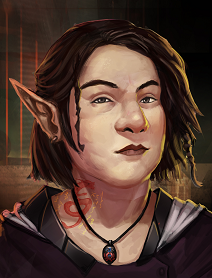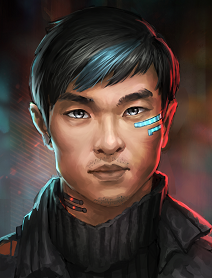Kickstarter has allowed a great bunch of good indies to see the light of day, funded by the very people that would want to play them. It has proven to be a platform for new projects, but, more recently developers looking to reboot series, or create games with a genuine retro feel have also turned towards it, proving ideal for those that would set trends aside and look towards the past. Harebrained Schemes are not new to this, having reached their third successfully funded project. Shadowrun: Hong Kong is the newest iteration in the rebooted series.
Shadowrun: Hong Kong shares the framework of previous games, both story and gameplay-wise. Once you get past the prologue you’ll run around the hub area, Heoi, where you’ll receive missions, buy equipment and rest in between runs. The tasks will take you through corporate offices, pirate ships, slums filled with the less fortunate, and, though this is commonplace for the series, the general feeling differs from that of locations in previous games. The mesh of soundtrack, writing and visuals manage to inspire an eerily different atmosphere just underneath the surface. This is most obvious in the hub area, Heoi which has more mysticism attached to it than both the anarchist-controlled Kreuszbazar and Seattle. The lore is, naturally, rooted in Chinese/Japanese tradition and philosophy. It makes one curious to see how despite being a place that’s just as run by corporations, greed and material interests as any other, it manages to retain its own specificity that seeps in through the cracks.
Visually, things have improved with Shadowrun: Hong Kong. The series always had an easily recognizable graphical style and the pre-rendered backgrounds do their part to add to this, while producing some nostalgia on the side. While the “meatspace” has received polished textures and better lighting, the Matrix has undergone significant revamping. It looks less blocky and more varied than it did in previous games. The tone of the color is slightly darker and, now and then, there’s the occasional dragon statue. The revamp does not stop here though. If in the past, entering the matrix would throw the player in turn-based mode from the very start, Shadowrun: Hong Kong has a different approach. You have the chance of running through virtual space in real time, the challenge being to avoid vision cones belonging to patrol drones that lurk around, checking for intruders.

This video is a guide, showing how to use custom portraits in Shadowrun Hong Kong. C:Program Files (x86)SteamsteamappscommonShadowrun Hong KongSRHKDataStreamingAssetsContentPacksHongKongartportraits Next Frequently asked questions Preparations for missions Prev Frequently asked questions Is it possible to sneak in the game?
Being detected raises your trace level, which when brought to maximum, calls some nasty security bots you’ll have to deal with, alongside potentially raising alarms throughout the building you’re in. The addition of Blocker IP’s is something that tends to grow old quite fast. You’ll go through a minigame where, unless you’ve acquired passwords, you have to memorize a sequence of numbers and type it in. This never shines in any way, becoming tedious and repetitive after a short while. The revamping of the Matrix was a good idea overall. So good, in fact, that I couldn’t help but wish they did this in Dragonfall, where you spend a considerably longer amount of time jacked in the Matrix. Controlling your character in this mode can get wonky, though, turning what you believed to be good positioning into a run in with the patrol drone’s field of vision. There is one other gripe to be had with the Matrix: the lack of player character animation. Player characters are stuck in mid-air while moving around the Matrix and while it’s far from breaking immersion, it does make things look a little awkward.
When outside a computer’s virtual innards, gameplay will feel familiar to players coming back to the series. The classes are the same as before: the gun and/or sword toting Street Samurai, the spell wielding Mage, spirit summoning Shaman, the teched-up Decker, the drone-controlling rigger, and the Combat Adept who solves his issues withfists and the purple aura surrounding them. Players can still create a class without selecting one of these archetypes. Apart from a new skill tree that unlocks extra cyberware (robotic implants that grant bonuses while increasing spell cooldowns), there’s not much that changed in the character progression. You’ll complete missions using your charisma and knowledge, your fists, blades and bullets, or both, all depending on your choice. Hong Kong allows characters with high charisma and intelligence to engage in fewer fights than its predecessors did and more often than not, it feels quite satisfying.
Shadowrun Hong Kong Guide
Shadowrun: World Without Walls is a mod for Shadowrun: Hong Kong that is set in cyberpunk Boston. The mod features an original story, as well as original environment art, character portraits, and level design reflecting the various neighborhoods of Boston.
Shadowrun Hong Kong Character Portraits Gallery
At the same time, on Normal difficulty, Hong Kong is much easier than Dragonfall proved to be, especially in the endgame. While story-wise, the build-up and mystery are quite well maintained throughout the game, the final boss felt like a pushover, leaving a bit of a bitter taste behind. The biggest change is the addition of a button, in the upper right corner of the screen, which allows you to initiate combat. The way the transition between the real-time and turn-based phases worked in the past is that you would wander around until you’d enter an enemy’s field of vision, giving them the first turn. Now the advantage is tilted in your favor and it’s a welcome addition that may save you some nuyen spent on buying extra med or revive kits.
Speaking of nuyen, the game’s currency, Hong Kong will force you to be a tad more selective with what you buy. I almost always felt like I was short on nuyen and the higher tier of spells cost a lot. I ultimately settled for a high-defense armor and bringing just one spell to rank four. I remember Dragonfall skirting around the same line, just being a bit more permissive. While nuyen don’t come that easily, karma points do. You will most likely be able to branch out at least a bit with the quantity of karma that’s available. I planned my character as a pure mage that also focused on charisma. By the time the final mission arrived I had Wisdom, Spellcasting and Body to the racial maximum and Charisma at the same point. I also decided to add some points in stats that would allow some Dodge in the end.
What’s special about Shadowrun is surely its vision of a future where magic and technology are both present with a hefty amount of dystopian elements added to the mix. That being said, the story is crucial to these games. Shadowrun Hong Kong’s story does not disappoint. It follows roughly the same general lines as Shadowrun Dragonfall and Shadowrun Returns but this time around, the scale of events is arguably smaller. While to some this will not prove as satisfactory, the story is held together quite decently by very well written dialogue and descriptions. You will learn about the plight of Hong Kong’s poor population, and the overarching structures that govern the place. Quite a lot of local specificity that comes from things such as Qi manifesting physically will be mentioned, alongside various beliefs held by the characters you’ll speak with. Unfortunately, the ending doesn’t do it justice, being that type of cliché to which you roll your eyes in disappointment regarding the missed opportunity. Shadowrun: Hong Kong boasts two of the best, if not the very best, team members the series has seen. Sadly, they end up eclipsing the others in personality, outlook on the world and combat. A few minor errors, some grammatical, other pertaining to missing words and character portraits not changing at the appropriate time, have also slipped in, but, just like in the case of the missing animation, they are minor and can be easily overlooked.
Truth be told, some players have signaled game-breaking bugs in a couple of places. I did not encounter any of them, and none seemed to be widespread. Thus, what do we get when we draw the line? We get more Shadowrun and that is far from being a bad thing. What’s new is found mainly in the rather significant Matrix overhaul, the possibility to initiate combat whenever you feel like it and the atmosphere in Heoi. Apart from that, those returning will be met with a lot of familiarity; the good kind of familiarity. The kind that emanates from the result of a recipe that worked in the past and still has life in it, thanks to its ingredients. Thus, unless you were expecting something entirely different from the series, it’s irrelevant whether you’re a new or an old player. Shadowrun: Hong Kong is definitely worth grabbing and playing through at least once as it lies on the higher spectrum of available cyberpunk RPGs.

MateÈ™ Bogdan Robert, NoobFeed
Facebook | Twitter
